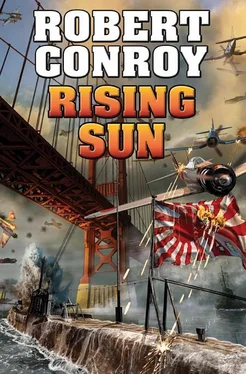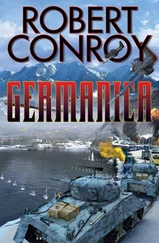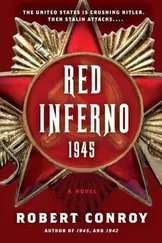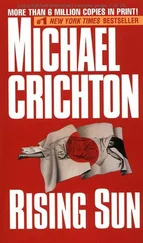* * *
Yamamoto felt the battleship quiver. He barely heard the explosion and saw nothing. The battleship’s massive superstructure blocked his view and insulated him from any sound.
“Torpedo,” announced a grim-faced aide a moment later. “No apparent damage, sir.”
Yamamoto nodded. It was what he expected. What else could go wrong this terrible day? He had been totally outwitted and outfought by an American Navy he had thought was, if not dead, then moribund and too frightened to take risks. Now all he could do was try and salvage something out of the burning wreckage that had once been the pride of the Imperial Japanese Navy. Four of his prized carriers were in sinking condition and were being abandoned. If they didn’t sink on their own, they would be torpedoed by their own ships, a totally inglorious and shameful end to their careers. Two other carriers were seriously damaged, burning furiously, and might also be lost. Worse, if there could possibly be a worse, the carriers lost were the largest and most powerful the Imperial Japanese Navy possessed. The only carriers remaining were the smaller ones now being categorized as escort carriers.
Nor did it matter that the American carrier they’d sought for so long, the Saratoga , had at least been very badly damaged. The few Japanese pilots who had survived the attack on her reported her burning and, in their opinion, likely to sink. Yamamoto was not so confident. The Americans were magicians at saving and repairing ships and, besides, what did it matter if the Saratoga was sunk? The Americans had many others under construction. They would join up with what was thought to be the Essex -class carrier that had accompanied the Saratoga and do so well before Japan could recover from today’s disaster.
His thoughts returned to the doomed pilots. At least four hundred of them had been lost and that toll was likely to go higher. Four hundred highly trained carrier pilots could not be replaced. At the current rate of pilot graduation, any damaged carriers were likely to be repaired and ready long before the pilots were trained according to traditional standards. Thus, those standards would have to be relaxed, which meant that new Japanese carrier pilots would be lambs to the slaughter. Nor could the even larger number of planes lost be replaced in the foreseeable future.
Yamamoto accepted that the defeat was his responsibility. All decisions had been his. He would go to Tokyo and personally apologize to the emperor for his failure to bring victory to Japan. It wouldn’t matter that this was just as he had forecast that summer before the attack on Pearl Harbor. He had accepted command of the fleet and the blame was his. He would offer his resignation to the emperor and the prime minister. He didn’t think they would take it, although he now wished they would. He would let them change his mind about resigning, of course, and do his utmost to save the empire, but he would also try to convince Tojo and Hirohito of the need to negotiate a peace with the Americans. The British could be ignored, but not the Americans. The war in the Pacific would largely be a naval war and the Imperial Japanese Navy would be overwhelmed by the U.S. Navy if it went on much longer.
In order to do this, he thought, the Americans would first send forces to reestablish a forward base at Pearl Harbor, which would also rescue the Hawaiians from their near starvation. The blockade of Australia would be lifted and Japanese garrisons in the Solomons would have to be abandoned. Japan would have to pull back or be destroyed. It was his duty to convince the government of this inevitable fate.
Captain Miyazato Shotoku commanded the Yamato . He now approached the admiral with eyes down. He was clearly shaken and seemed almost afraid to speak.
“What is the news?” Yamamoto asked softly. From the man’s expression, it could not be good.
Shotoku took a deep breath and swallowed. What he had to say was painful in the extreme. “We were struck by one American torpedo. It has jammed our rudder. We are stopping so we can send down a diver to determine whether it can be repaired. Otherwise, we can only steam in very large circles. We are not optimistic about the outcome. It is very likely that we will not have the tools and equipment to effect the repairs. I believe it can only be done in drydock.”
Yamamoto sucked in his breath. It was almost the same thing that had happened to the German superbattleship, the Bismarck , in May of 1941. Unable to retreat and doomed to steam in circles, she had been surrounded by British ships and blown to pieces. Would the same happen to the Yamato , the pride of Japan? It was unthinkable. At least he’d had the dubious pleasure of watching as the Yamato’s mighty 18.1-inch guns fired over the horizon at San Diego. But would that be the ignominious end of her military career? Not if he could help it.
“The Kongo will take the Yamato in tow if quick repairs cannot be made,” Yamamoto said to Captain Shotoku. “We cannot sit here and wait. The Americans will be here shortly.”
Shotoku nodded and left. Orders would be made for the battleship Kongo to tow the larger Yamato out of danger. The two ships’ rate of speed would be slow and they would be vulnerable until they were out of range of American land-based planes. In the meantime, Yamamoto gave instructions that he and his staff would transfer to another ship, the destroyer Umikaze , which was close by. At less than one tenth the size of the Yamato , he and his staff would be cramped, but they would get away to fight another day.
But the crew of the Yamato would not be so fortunate. He had no illusions. It was extremely likely that the American planes and ships would find and attack the two battleships with overwhelming force. The gambler in him estimated the two battleships’ chances of survival as one in fifty.
Many of the Yamato ’s crew would not look at him and those who did showed faces full of dismay, disappointment, shock, and anger. Japan had been defeated. How could that be? Yamamoto had no answer. All he knew was that the men of the Yamato would likely all die within the next few hours unless a miracle occurred, and he did not believe in miracles. He accepted their anger at him as his due. He had failed.
* * *
The floatplanes reported that the navy fighters and bombers had ceased their attacks on the two Japanese battleships. One, the Kongo , was reported to be down at the bow and barely making headway, while the other, the monster Yamato , still steamed slowly. The Kongo had been towing the Yamato , but they had separated.
American pilots confirmed that the Yamato was moving in a wide circle to starboard. Skillful ship handling had enabled the Yamato to lengthen the distance between herself and both the coast of California and the approaching American carrier. At the rate she was moving, however, it would take an eternity for her to make it to safety.
The United States Navy in the Pacific was again down to one aircraft carrier, the Essex , and she was just about out of ordnance. Her bombs had been used up and so too had her pilots. A couple of planes had crashed while trying to land on the Essex , which caused Admiral Spruance, now on the battleship Washington , to call a halt to the attacks. The Essex would be resupplied and her pilots rested before she resumed the fight.
Thus, the older battleships and Admiral Jesse Oldendorff entered the field of battle. The Colorado and Mississippi had been augmented by the Pennsylvania , a survivor of the attack on Pearl Harbor. The admiral now flew his flag on the Pennsylvania , which he considered appropriate when he thought of her history and her resurrection from Pearl Harbor. Admiral Nimitz’s foresight in moving his squadron from Puget Sound to join with the Pennsylvania at San Francisco caused Oldendorff to smile. He wanted nothing more than to strike back with his battleships before they were sent to a museum. The defeat of the Japanese squadron off Anchorage, while satisfying, had not been enough. He and the ships’ crews all wanted a shot at the enemy, battleship to battleship. It didn’t matter if the Kongo and Yamato were damaged; he wanted his ships’ guns in at the kill.
Читать дальше












